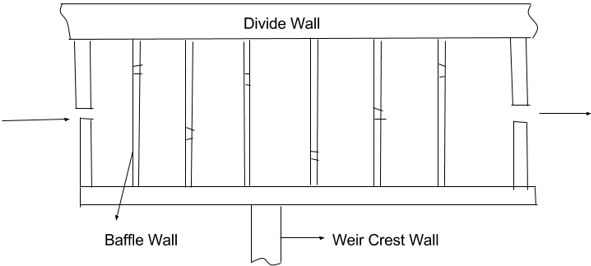This set of Irrigation Engineering Multiple Choice Questions & Answers (MCQs) focuses on “Diversion Head Works and its Components”.
1. Into how many components the diversion headwork is divided?
a) 8
b) 5
c) 4
d) 7
View Answer
Explanation: The diversion head work is generally divided into eight component parts, namely weir, divide wall, fish ladder, pocket or approach ladder, scouring sluices, silt prevention devices, canal head regulator, and river training works.
2. In order to find the proper location for the head works on the river, the river is divided into how many stages?
a) 5
b) 2
c) 3
d) 4
View Answer
Explanation: In order to find an appropriate location for the head work on the river, the river is divided into four stages. They are mountainous stage, boulder stage, alluvial plain, and delta stage.
3. What does the diagram represent?

a) Divide Wall
b) Plan of Fish Ladder
c) Scouring Sluices
d) Canal Head Regulator
View Answer
Explanation: The figure represents the plan of a fish ladder installed in the channel, where the water comes to the channel from end and leaves it at the other end. Baffle walls are also provided in the path to control the silt and sediment load and also the velocity of the flow, thus helping the fish.
4. Divide wall helps in concentrating scouring action.
a) True
b) False
View Answer
Explanation: If perhaps divide wall is not provided then the currents approach the scouring sluices from all directions and their effectiveness is reduced. Thus the dividing wall helps in concentrating the scouring action of the under sluices from washing out the silt deposited in the pocket.
5. Head regulator helps in controlling the flow in the canal.
a) False
b) True
View Answer
Explanation: As the name itself suggests (regulator) head regulator helps in regulating the supply of flow easy in a canal, controls silt entry into the canal, and shut river floods.
6. By constructing which structure we can help the fish in their migration?
a) Scouring Sluices
b) Silt Excluder
c) Fish Ladder
d) Divide Wall
View Answer
Explanation: Before the start of monsoons the fish migrate to the upstream in search of warm water. So, therefore some provision is made to make some space available for them to travel. And this achieved by the construction of fish ladder as they provide the room for movement and also slows down the flow for easy traveling of fish.
7. What device is placed in front of head regulator for silt removal?
a) Weir
b) Silt Extractor
c) Silt Excluder
d) Barrage
View Answer
Explanation: Silt excluder is placed in front of the head regulator by which the silt is removed from the water even before the water enters the canal. The fundamental principle on which this device acts is the fact that stream carrying silt in suspension, the concentration of silt charge is more in upper layers than in lower layers. Therefore this device is so designed for separating these two layers without disturbance.
8. Which device is used for silt removal after it enters the canal?
a) Silt Excluder
b) Silt Ejector
c) Weir
d) Barrage
View Answer
Explanation: This device can be called as a failsafe device in case the silt excluder does not work properly or the silt charge is beyond the capacity of the silt excluder. This device removes or ejects or extracts the silt which has entered the canal and is thrown out. This device placement is a curative measure and is constructed at some distance from the head regulator.
9. Depending on how many considerations the capacity of under sluices is fixed?
a) 5
b) 4
c) 2
d) 3
View Answer
Explanation: The discharging capacity of an under sluice is fixed by the considerations like to ensure proper scouring and its capacity should be double the canal discharge, sluices should of sufficient capacity to discharge winter freshlet, and during floods 10 to 15 percent of maximum flood discharge should be done.
10. How many river training works are needed on the canal head works?
a) 5
b) 3
c) 4
d) 2
View Answer
Explanation: Three river training works are needed on the canal head works, to prevent the river from outflanking the works due to a change in its course and ensure smooth and an axial flow of water. The works include guide banks, marginal bunds, and spurs. Guide banks force the river into the restricted channel, thus ensuring smooth and axial flow near the weir site. In order to protect the area from submergence due to raise in HFL these marginal bunds are provided. The spurs are the works that protect the marginal bunds.
Sanfoundry Global Education & Learning Series – Irrigation Engineering.
To practice all areas of Irrigation Engineering, here is complete set of 1000+ Multiple Choice Questions and Answers.
If you find a mistake in question / option / answer, kindly take a screenshot and email to [email protected]
- Practice Agricultural Engineering MCQs
- Check Irrigation Engineering Books
- Practice Civil Engineering MCQs
- Check Agricultural Engineering Books
- Apply for Agricultural Engineering Internship
